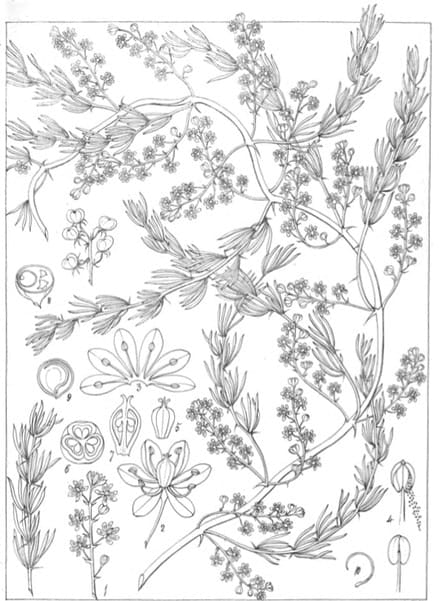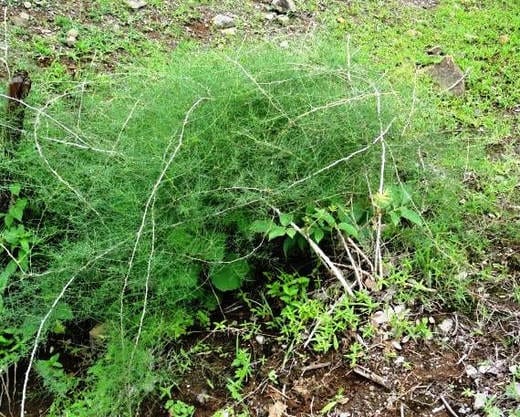Asparagus racemosa, Shatavari
Indian AsparagusShatavari (Ayurveda)
Satavar (Unani)
Nye Shing ཉེ་ཤིང༌ (Tibetan)
 Figures of Indian Plants, Wight, 1853
Figures of Indian Plants, Wight, 1853 Asparagus racemosus
Asparagus racemosusPhoto by S.K. Gawali
Botanical name:
Asparagus racemosus
Others used include A. sarmentosus, A. curillus, A. filicinus
Parts used:
Root
Temperature & Taste:
Cool, moist. Sweet
Uses:
1. Nourishes Blood and Yin, Regulates Menstruation:
-considered a special tonic medicine for women and female disorders in Ayurveda.
-promotes menstruation when lacking and hinders when too excessive.
-nourishes Blood and benefits female hormones; benefits Fertility
2. Benefits the Kidneys, Nourishes Yin
-Increases Sperm
–Rasayana (Ayurveda); tonic for children and the aged.
-regarded as aphrodisiac (Ayurveda, Unani)
3. Promotes Milk
-increases supply and quality of Breast Milk
4. Resists Poison:
-root decoction is given for Rabid Dog bite in India
5. Externally:
-widely used in oils, for dryness of the skin, aggravated Wind, and weakness of the muscles and joints
Dose:
To nourish Yin and Essence, and increase Sperm, it is often boiled in Milk, or taken with Ghee in India.
It can be decocted with wine to promote menstruation
Powder: 2–6 grams
Decoction: 3–9 grams (to 30 grams daily).
Substitutes:
1. Soloman’s Seal (P. multiflorum) is an accepted substitute for Shatavari in Ayurveda.
2. Common Asparagus is similar and may be substituted as a Yin tonic.
Main Combinations:
1. As an aphrodisiac and kidney tonic, Impotence:
i. Asparagus racemosus with Withania and Tribulus seed
ii. Asparagus racemosus with Salep, Almond, Saffron
iii. Impotence, Sida cordifolia with Sesame seed, Tinospora (Guduchi), Asparagus racemosa (Shatavari), Mucuna, Emblic Myrobalan (Ashtanga Hridaya)
2. Promote Fertility in male and female:
i. Asparagus racemosus with Withania
ii. Asparagus racemosus with Withania, Asparagus adcendens, Tribulus seed, Frankincense
3. Increase quality and quantity of Sperm:
i. Asparagus racemosus with Withania, Mucuna, Emblic Myrobalan
ii. Asparagus racemosus with Withania, Shilajit
iii. Asparagus racemosus with Withania, Tribulus seed, Zinc Bhasma
iv. Asparagus racemosus with Orchis
4. As a female tonic:
i. Asparagus racemosus combines well with Dang Gui
ii. Asparagus racemosus, Rose, Pearl
5. As a childhood tonic:
i. Asparagus racemosus with Rose, Emblic Myrobalan, Withania, Calamus (as in Balivivan)
ii. Asparagus juice is heated gently with Coconut milk, Cow Milk, Ghee, China root and Cardamon. This forms a nourishing tonic for emaciated children. (Shatavari Ghritam)
6. Promote and regulate Menstruation:
i. Asparagus racemosus with Cyperus rotundus, Rose, Saraca
ii. Asparagus racemosus with Dang Gui, Safflower
iii. Asparagus racemosus with Gymnadema, Solomans Seal, Aloeswood, Nutmeg (as in Warm the Palace 7 Pill)
7. Uterine Bleeding, Asparagus racemosus with Adhatoda, Rose
8. Prevent Miscarriage:
i. Asparagus racemosus with Saraca and Madder
ii. Asparagus racemosus with Pearl, Red Coral
9. Increase Milk quality and quantity, Asparagus racemosus, Fennel seed, Celery seed
10. Colitis:
i. Asparagus racemosus, Emblic Myrobalan, Madder, Picrorrhiza
ii. Asparagus racemosus with Costus, Licorice
11. Epilepsy, Asparagus racemosa, Centella, Calamus, Costus,
12. Lung heat Cough, Asparagus racemosus with Licorice, Adhatoda
13. Difficult, painful urine, hematuria, Asparagus racemosus with Sandalwood, Tribulus
Major Formulas:
Asparagus Ghee (Shavatari Ghritam) (Ayurveda)
Balivivan (Ayurveda)
Cardamon 7 (Sug smel 7) (Tibetan)
Cyavanaprash (Ayurveda)
Dhatuvallabha Churna (Ayurveda)
Essence Pills (Bcud len ril bu) (Tibetan)
Mandala of the Sun (Se bru nye dkyil) (Tibetan)
Powder to Strengthen in Pregnancy
Warm the Palace 7 Pill
Cautions:
1. Avoid in spleen weakness with loose bowels
2. Research has shown that it should be used cautiously in pregnancy. (see here)
Toxicity
Acute toxicity tests showed no toxicity with large doses. (see here)
Main Preparations used:
|
‘These two plants [A. racemosus and A. sarmentosus] appear to be the Satavari and Maha-satdvari of the Nighantas: among the synonyms of the first, we find Dvipika, Dvipa-satru, Vara- ghantika, Narayani, and Sata-padi; the synonyms of the second are very similar, amongst them we note Bahu-puttrika, Dagdha, and Bhasma-roha. Both plants are considered to be heavy and cold, sweet, demulcent, galactogogue, tonic, and strengthening, and to remove bilious and rheumatic humors, blood diseases, and swellings; they are used both internally and in the preparation of several medicated oils. The tubers are candied and eaten as a sweetmeat. The fresh juice of the root is given with honey as a demulcent in bilious dyspepsia or diarrhoea (Sdrangadhara). As an aphrodisiac, Chakradatta directs four sers of the juice of the roots and four sers of ghi [ghee] to be boiled in forty sers of milk, and to be flavoured with sugar or honey, and long pepper. The chief use of the drug, however, is in the preparation of medicated oils for external application in nervous and rheumatic affections and urinary |
disorders. The Narayam taila, a popular remedy of this kind, contains the barks of Aegle Marmelos, Premna integrifolia, Oroxylum indicum, Erythrina indica, Stereospermum suaveolens, and Poederia foetida; the roots of Withania somnifera and Boerhaavia repens, the fruit of Tribulus terrestris, and the leaves of Solanum xanthocarpum, Bolanum indicum, Sida cordifolia and Sida rhombifolia, of each twenty tolas. The whole collection is boiled in 64 sers of water down to one-fourth and strained. To the strained decoction is added four sers each of the juice of Satavari and prepared sesamum oil, sixteen sers of cows’ or goats’ milk, and a paste prepared with four tolas of each of the following drugs— Fennel seeds, wood of Cedrus Deodara, root of Nardostachys Jatamami, liquid storax, Acorus root, Sandalwood, herb of Limnanthemum cristatum, Costus, Cardamoms, leaves of Desmodium gangeticum, of Uraria lagopoides, of Phaseolus trilobus, and of Teramnus labialis, roots of Withania somnifera, Vanda Roxburghii, and Boerhaavia repens, rock salt. The whole is then reboiled and perfumed. (Chakradatta.)’ (Pharmacographia Indica, Dymock, 1893) |
